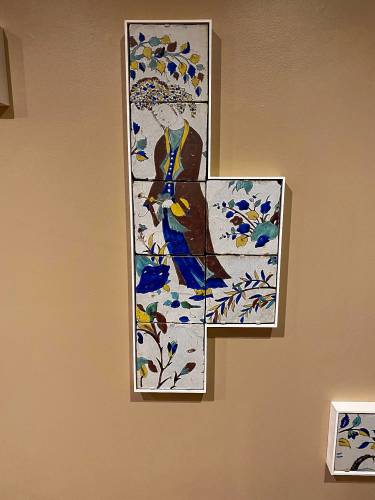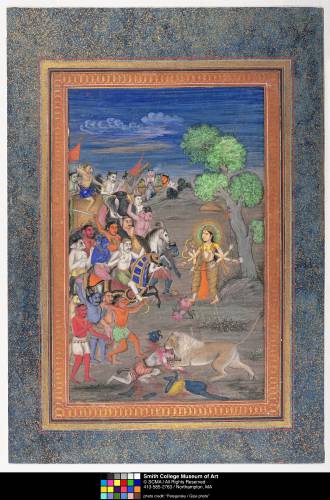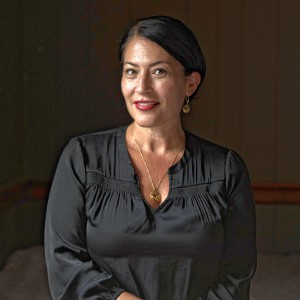Art that traveled far, wide: Smith College exhibit showcases venerable art from the Persianate world
|
Published: 02-08-2024 3:29 PM
Modified: 02-09-2024 9:03 AM |
Before it became recognized by its modern name in 1935, Iran was known for centuries — at least in the western world — as Persia, a name that reflected the language of the same name and the culture that was part of it.
In the 1970s, academics coined another term — Persianate — to describe a society based on or influenced by Persian language and culture, as well as literature and art. That influence, scholars say, extended well beyond the physical boundaries of Persia/Iran for hundreds of years.
A new exhibit at the Smith College Museum of Art takes a close look at some of that art, tracing work that in many cases dates back hundreds of years and which connected people and ideas across a region stretching from Iran to modern-day India and Bangladesh.
“Painting the Persianate World: Portable Images on Paper, Cloth and Clay” includes manuscript illustrations, dye-painted textiles, and decorated ceramics, primarily from the 13th to 19th centuries, that showcase a number of mediums and speak to a history in which artistic motifs and ideas journeyed thousands of miles across mountains, deserts and rivers.
SCMA officials say the new exhibit is the first comprehensive project at the museum to examine Iranian and Indian art from the perspective of multiple mediums.
“Portability was a big part of what enabled these motifs to move beyond borders,” said Amherst College professor Yael R. Rice during a recent tour of the exhibit.
Rice, who specializes in the art and architecture of South Asia and Greater Iran, co-curated the exhibit with Yao Wu, curator of Asian Art at SCMA.
Rice noted that a recent Smith graduate as well as a graduate student from the University of Massachusetts Amherst also helped with the exhibit, while the artwork itself, though drawn primarily from the SCMA collection, includes materials from Amherst and Mount Holyoke colleges (and a few other sources).
Article continues after...
Yesterday's Most Read Articles
 Police report details grisly crime scene in Greenfield
Police report details grisly crime scene in Greenfield
 Super defers Amherst middle school principal pick to successor; one finalist says decision is retaliation for lawsuit
Super defers Amherst middle school principal pick to successor; one finalist says decision is retaliation for lawsuit
 Homeless camp in Northampton ordered to disperse
Homeless camp in Northampton ordered to disperse
 Authorities ID victim in Greenfield slaying
Authorities ID victim in Greenfield slaying
 Haydenville residents resist Greenway trail plan, float alternative design
Haydenville residents resist Greenway trail plan, float alternative design
 Locking up carbon for good: Easthampton inventor’s CO2 removal system turns biomass into biochar
Locking up carbon for good: Easthampton inventor’s CO2 removal system turns biomass into biochar
“So it’s at least a four college effort,” she said with a laugh.
Rice and Wu say painting in the Persianate world held a different meaning than it did in the West. The painted works in the exhibit are drawn largely from what’s know as “dispersed manuscripts,” for which they were used as illustrations to help tell a story, Wu said.
Wu noted that as these manuscripts — an early form of literature — were carried by different people across the broad region of today’s Iran and Afghanistan to present-day Pakistan, India and Bangladesh, they helped spread many artistic ideas and styles of storytelling.
“These were not large paintings that could not easily be moved,” said Wu. “They were portable, their ideas and styles were portable.”
Some of the earliest illustrations and writing in the exhibit date from “The Book of Kings,” or “Shahnama,” an epic poem — 50,000 rhyming couplets — by the Iranian poet Abu’l Qasim Firdawsi that he began around A.D. 977 and did not complete until about A.D. 1010.
It’s a story of the kings of Iran from the dawn of civilization until Islam arrived in the country in the 7th century. As exhibit notes explain, that story became so popular that many Iranian and non-Iranian “elites” commissioned their own copies in the succeeding centuries, making “The Book of Kings” a key element in forming the Persianate world.
A number of the exhibit illustrations appear with text or with some kind of backing, indicating they were indeed once part of a larger manuscript. Most are composed on paper, the art created from opaque watercolor, ink and gold, and they’re notable both for their rich colors and imaginative story lines.
For instance, Rice pointed to a late 18th century illustration from India, “Battle Between Hanuman and Kumbhakarna,” that she said employed a technique known as “continuous narrative,” in which the artist “combined multiple events in a single frame.” (In the work, Hanuman is a monkey god who fights a large demon, Kumbhakarna.)
“The artist plays with scale to show the passage of time,” said Rice, who noted that Hanuman and his monkey army are shown three times, while Kumbhakarna, because of his size, is only depicted twice.
Wu and Rice noted that artistic ideas and motifs also journeyed from Iran on cloth, such as tapestries and other wall hangings, and on ceramics.
In an exhibit featuring many small illustrations that were once part of manuscripts — a few artworks have magnifying glasses placed nearby so that visitors can better examine the details — two of the larger works on display are collections of painted tiles.
“Garden Party,” for instance, consists of 12 colorful tiles, previously separated but now arranged in a square, that were likely painted in Iran in the 17th or 18th century. They depict a female dancer and a few musicians performing for a number of men who drink tea or wine in an ornate walled garden.
An even more engaging display is built from seven somewhat larger painted tiles, arranged on the gallery wall in the shape of a rough key, that depict a “saqi” (a cupbearer), an Iranian court officer from the 16th century whose duties would have included serving at royal tables.
The artwork — stonepaste with paint and polychrome glaze — is beautiful, but what’s most interesting is the origin of the work. Wu explained that the tiles were once part of an elaborate design on the front of a pavilion in Isfahan, the capital of Iran’s Safavid Dynasty (1501-1722).
Exhibit notes include a picture taken of the original tile design on the pavilion by Dutch photographer Albert Hotz sometime in the late 19th or early 20th century.
That’s worth noting, Wu says, as a reminder that many of the works in the SCMA exhibit have come to the museum (and other museums) from 20th century western art collectors who acquired them without knowing or perhaps caring about their original contexts.
“That’s one of the things we wanted to do — show this art in the way it was originally presented, or explain how it was presented,” she said.
“Painting the Persianate World” runs through July 7 at the Smith College Museum of Art.
Steve Pfarrer can be reached at spfarrer@gazettenet.com.














 The Iron Horse rides again: The storied Northampton club will reopen at last, May 15
The Iron Horse rides again: The storied Northampton club will reopen at last, May 15 The power of poetry: U.S. Poet Laureate Ada Limón to speak at Smith College
The power of poetry: U.S. Poet Laureate Ada Limón to speak at Smith College Upon Nancy’s Floor: 33 Hawley event celebrates iconic dancers, history, and a new dance floor
Upon Nancy’s Floor: 33 Hawley event celebrates iconic dancers, history, and a new dance floor Embracing both new and old: Da Camera Singers celebrates 50 years in the best way they know how
Embracing both new and old: Da Camera Singers celebrates 50 years in the best way they know how
